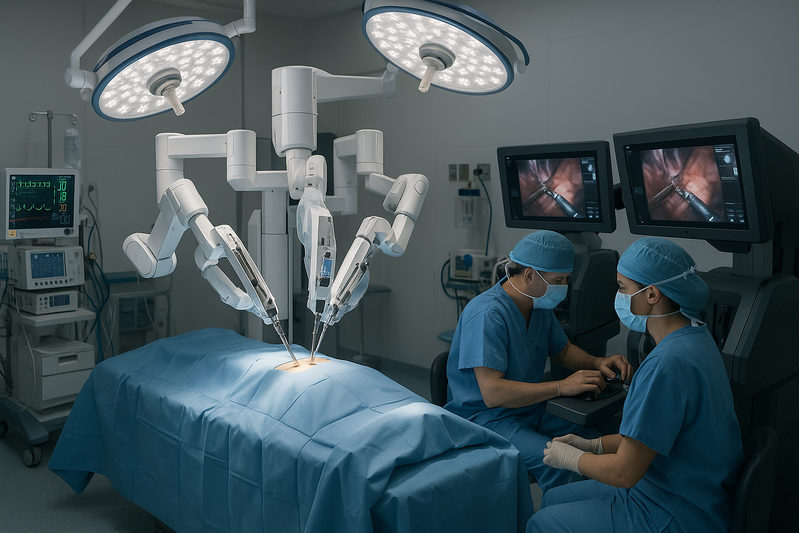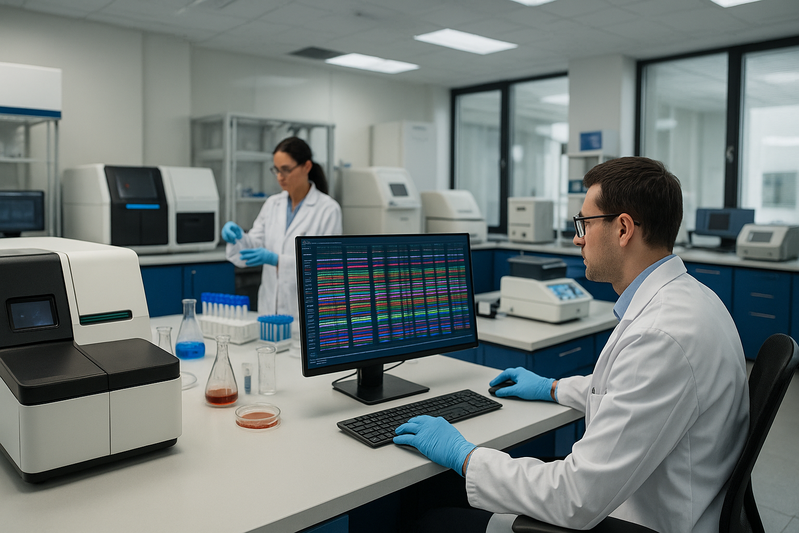The healthcare industry is experiencing a technological revolution that is fundamentally changing how care is delivered, managed, and experienced by patients. As we move through 2025, several key technologies are at the forefront of this transformation, promising to improve patient outcomes, increase accessibility, and reduce costs across global healthcare systems.
At Aries Star Marketing OPC, we work closely with healthcare providers across Asia, Europe, and the Middle East to implement these cutting-edge technologies. In this article, we'll explore the five most significant healthcare technology trends that are reshaping the industry this year.
1. AI-Powered Diagnostics and Predictive Analytics
Artificial intelligence has moved beyond being a buzzword to become an essential tool in modern healthcare. In 2025, AI systems are increasingly being used to analyze medical images, detect patterns in patient data, and predict health outcomes with remarkable accuracy.
Advanced machine learning algorithms can now detect subtle abnormalities in radiological images that might be missed by the human eye. For example, AI systems can identify early signs of lung cancer in CT scans with 94% accuracy, compared to 69% accuracy achieved by radiologists working alone.

Predictive analytics is another area where AI is making significant strides. By analyzing vast amounts of patient data, these systems can identify individuals at high risk for specific conditions, enabling preventive interventions before symptoms appear. One hospital network in Southeast Asia reported a 32% reduction in readmission rates after implementing an AI-based predictive system that identifies patients at risk of complications following discharge.
"The integration of AI into diagnostic processes isn't about replacing healthcare professionals—it's about augmenting their capabilities and allowing them to make better-informed decisions." — Dr. Mei Lin, Chief Medical Information Officer at Singapore General Hospital
2. Advanced Telemedicine and Remote Patient Monitoring
The global pandemic accelerated the adoption of telemedicine, but in 2025, we're seeing this technology evolve far beyond simple video consultations. Today's telemedicine platforms integrate with wearable devices, electronic health records, and home diagnostic tools to create comprehensive virtual care environments.
Remote patient monitoring (RPM) systems now allow healthcare providers to track vital signs, medication adherence, and disease-specific metrics in real-time. Patients with chronic conditions like diabetes, hypertension, and heart failure can be monitored continuously without frequent in-person visits, leading to better disease management and fewer hospitalizations.

In rural areas across Asia and the Middle East, telemedicine is addressing critical physician shortages. Mobile health clinics equipped with telemedicine technology connect patients to specialists hundreds of kilometers away, bringing expert care to previously underserved communities.
The latest telemedicine platforms also incorporate natural language processing to overcome language barriers and cultural differences, making healthcare more accessible to diverse populations. This is particularly valuable in multicultural regions like the UAE, where healthcare providers serve patients from dozens of different nationalities.
3. Blockchain for Secure Health Data Management
As healthcare becomes increasingly digitized, securing sensitive patient information while ensuring it remains accessible to authorized parties has become a critical challenge. Blockchain technology is emerging as a powerful solution for managing electronic health records (EHRs) securely and efficiently.
Blockchain-based health record systems provide several key advantages:
- Enhanced security: The decentralized nature of blockchain makes it extremely difficult for hackers to compromise patient data
- Improved interoperability: Different healthcare providers can securely access and share patient information across systems
- Patient control: Individuals can grant and revoke access to their medical records, maintaining ownership of their health data
- Immutable audit trails: All access to records is permanently logged, ensuring accountability

Several major hospital networks in Europe have implemented blockchain-based systems for managing patient consent and data sharing between institutions. These systems have reduced administrative costs by up to 25% while significantly improving data security compliance.
In the pharmaceutical supply chain, blockchain is being used to track medications from manufacturer to patient, helping to combat the global problem of counterfeit drugs. This is particularly important in regions where pharmaceutical counterfeiting has been a persistent issue.
4. Robotics and Automation in Surgical Procedures
Robotic surgery has evolved dramatically in recent years, with the latest systems offering unprecedented precision, flexibility, and control. In 2025, robotic surgical assistants are becoming standard equipment in operating rooms around the world.
The newest generation of surgical robots features haptic feedback, allowing surgeons to "feel" tissues remotely, and advanced 3D visualization systems that provide enhanced views of the surgical field. These capabilities enable minimally invasive procedures for increasingly complex surgeries, resulting in smaller incisions, less pain, faster recovery times, and reduced complications.

Beyond the operating room, robots are taking on various roles in healthcare settings:
- Autonomous delivery robots transport medications, supplies, and laboratory samples throughout hospitals
- Disinfection robots use UV light to sanitize hospital rooms, reducing the risk of healthcare-associated infections
- Exoskeletons help rehabilitation patients regain mobility after strokes or spinal injuries
- Companion robots provide social interaction and medication reminders for elderly patients
A leading hospital in Dubai recently reported that its robotic surgery program has reduced average hospital stays by 40% and post-surgical complications by 30% compared to traditional surgical approaches.
5. Personalized Medicine Through Genomics and Digital Twins
The era of one-size-fits-all medicine is giving way to highly personalized approaches based on an individual's genetic makeup, lifestyle factors, and real-time health data. Advances in genomic sequencing have made it faster and more affordable to analyze a patient's genetic profile, enabling treatments tailored to their specific genetic characteristics.
In oncology, this approach has led to targeted therapies that attack cancer cells with specific genetic mutations while sparing healthy cells, resulting in better outcomes and fewer side effects. Similar approaches are being applied to other conditions, from cardiovascular disease to mental health disorders.

Digital twin technology represents the cutting edge of personalized medicine. These sophisticated computer models simulate an individual patient's physiology, allowing clinicians to test different treatment approaches virtually before applying them to the actual patient. This technology is particularly valuable for complex cases where the optimal treatment isn't immediately clear.
A research hospital in France has pioneered the use of digital twins for cardiac patients, creating detailed models of individual patients' hearts to plan surgical interventions and predict outcomes. This approach has improved surgical success rates by 28% for complex cardiac procedures.
Implementation Challenges and Considerations
While these technologies offer tremendous potential, healthcare organizations face several challenges in implementing them effectively:
- Cost and ROI: Many advanced healthcare technologies require significant upfront investment
- Integration with existing systems: New technologies must work seamlessly with legacy systems
- Staff training and change management: Healthcare professionals need training and support to adopt new tools
- Regulatory compliance: Technologies must meet stringent healthcare regulations that vary by region
- Ethical considerations: Issues around data privacy, algorithmic bias, and equitable access must be addressed
At Aries Star Marketing OPC, we help healthcare organizations navigate these challenges through comprehensive digital transformation strategies that address technology implementation, staff training, regulatory compliance, and change management.
Conclusion: The Future of Healthcare Technology
The healthcare technology trends of 2025 represent a fundamental shift in how care is delivered and experienced. By embracing AI diagnostics, advanced telemedicine, blockchain security, surgical robotics, and personalized medicine, healthcare providers can improve patient outcomes, increase accessibility, and create more efficient healthcare systems.
As these technologies continue to evolve, we can expect even greater integration between them, creating synergistic systems that are more than the sum of their parts. The future of healthcare is increasingly digital, personalized, and accessible—and that future is arriving faster than many anticipated.
For healthcare organizations looking to stay at the forefront of these technological advances, partnering with experienced technology consultants who understand both the technical aspects and the unique challenges of healthcare implementation is essential for success.





